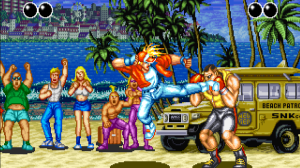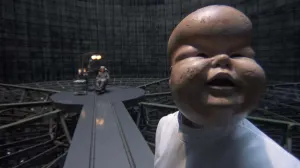For fan of SpongeBob SquarePants, the popular Nickelodeon animated series is just, as the theme song says, about a square yellow sponge living in a pineapple under the sea, his world one of “nautical nonsense” that has delighted fans of all ages for 20 years. Not everyone sees it in such a simple and innocuous light, however. For University of Washington professor Holly M. Barker, SpongeBob and the other characters inhabiting his world in Bikini Bottom such as Squidward and Patrick Star aren’t just harmless entertaining cartoon icons — their “violent” and “racist” colonizers.
Videos by ComicBook.com
In an article entitled “Unsettling SpongeBob and the legacies of Violence on Bikini Bottom” published in “The Contemporary Pacific: A Journal of Island Affairs”, Barker presents an argument that SpongeBob SquarePants as well as the other characters in the series are normalizing the taking of land while also contributing to the erasure of the indigenous people living there, specifically referring to the location of Bikini Bottom being a real, non-fiction place.
“SpongeBob SquarePants and his friends play a role in normalizing the settler colonial takings of indigenous lands while erasing the ancestral Bikinian people from their nonfiction homeland,” Barker writes (via Fox News).
She goes on to note that the colonization of Bikini Bottom is “violent” and “racist”. She also makes the claim that the series is a whitewashed version of the real-life activities carried out by the American military against native populations in the Pacific.
To understand Barker’s argument, one has to understand a bit of American and world history as well as a popular fan theory about the Nickelodeon series. On SpongeBob SquarePants, the series is set in the undersea world known as Bikini Bottom. The location takes its named from the real-world Bikini Atoll — something that SpongeBob voice actor Tom Kenny confirmed in 2015 in an interview with HuffPost where he noted that Bikini Bottom is “kind of named after Bikini Atoll”. The real-world Bikini Atoll is a coral reef in the Marshall Islands that consists of 23 islands surrounding a central lagoon. Between 1946 and 1958, the United States military detonated 23 nuclear devices there both in the air and underwater. The inhabitants of Bikini Atoll were relocated in 1946 and some allowed to return in 1970 but it was soon discovered that the area remained highly radioactive and were removed again in 1980. The area remains mostly unhabitable to this day.
A popular fan theory about SpongeBob suggests that the world of Bikini Bottom is inhabited by creatures who were mutated by that nuclear testing. Specifically, a recent fan theory suggested that Mermaid Man and Barnacle Boy were Navy divers accidentally caught in the Bikini Atoll tests — specifically that the radiation had mutated and shrunk them. The general theory about Bikini Bottom inhabitants being mutated because of the nuclear testing has been largely debunked by Kenny, but Barker’s issues with SpongeBob go a bit further. She also points out cultural appropriation of general Pacific culture, including the use of Hawaiian-style shirts, the pineapple houses, the use of tikis and the moai of Easter Island.
None of that is to say that Barker doesn’t understand that SpongeBob SquarePants is just a cartoon and that the writers and creators probably didn’t think about the colonization aspect of things. Her concerns center around the lack of acknowledgement that “Bikini Bottom and Bikini Atoll were not for the taking” and that it leads children to “become acculturated to an ideology that includes the U.S. character SpongeBob residing on another people’s homeland.”
“We should be uncomfortable with a hamburger-loving American community’s occupation of Bikini’s lagoon and the ways that it erodes every aspect of sovereignty,” Barker writes.
What do you think? Let us know your thoughts on Barker’s arguments in the comments below.








